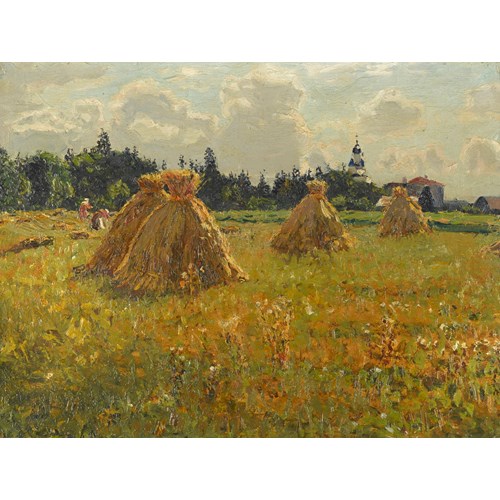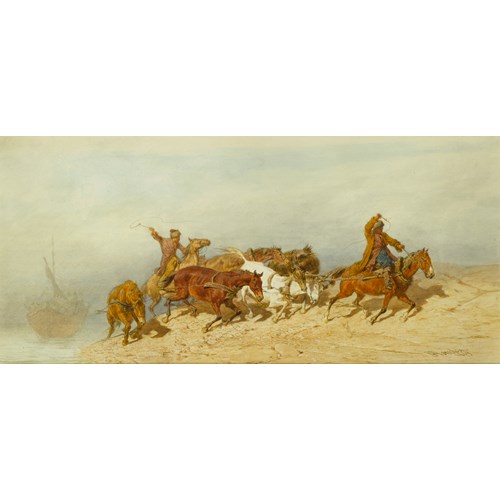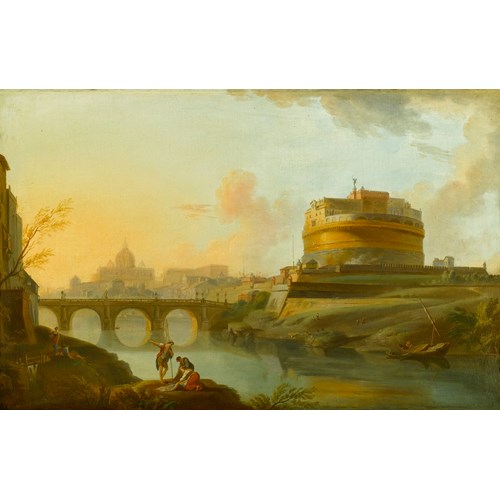Philippe de Momper
Landscape by a Riverside Town, said to be Treviso
Date Early 1620s
Epoque 1600-1750, 17th century
Origine Belgium
Medium Oil on oak panel
Dimension 47.4 x 77.9 cm (18⁵/₈ x 30⁵/₈ inches)
The attribution to de Momper is based on the research of Dr Klaus Ertz. In his 1986 monograph on Philippe’s father Joos de Momper (1564-1635), Ertz ascribed to Philippe a cohesive group of paintings, mainly depicting Treviso and Rome, including the present example, which had traditionally been attributed to Joos and known as the Treviso group.¹ A comparison with another work from the group, View of a Village beside a River, illustrates how consistent the works are in terms of content and style. A broad expanse of water runs vertically through the picture planes, linking foreground to back. The water is populated in both cases by villagers working on their boats, and on the river banks we see a range of buildings, from grand civic structures to humble dwellings. Stylistically these paintings must have been produced in the 1620s at the earliest, ‘owing to their composition and colour scheme’.² However, the paintings clearly have a significant Italian influence on them and although it is known that Joos travelled there during the 1580s³, there is no evidence of a second trip.⁴ Instead Ertz attributes the works to Philippe, who was very familiar with the style of his father, in whose studio he had learned and worked. Additionally he had recently visited Italy, travelling there with Jan Brueghel the Younger (1601-1678) in the early 1620s.
Little is known about de Momper’s life. He was born and died in Antwerp and in addition to his own independent works, he contributed staffage to the landscapes of his illustrious father. It is thought that he also had a brother, Gaspard, who was also a painter. His visit to Italy with Brueghel lasted two years and according to Arnold Houbraken he was an early member of the newly established Schildersbent in Rome. On his return in 1624, he is recorded as becoming a member of Antwerp’s Guild of St. Luke.
¹ See Ertz, K., Josse de Momper der Jüngere (1564-1635) (Freren 1986), pp. 414-424, 452-3 and 642-3, cat. nos. A131-A136, reproduced
² Ibid., p.453.
³ See Gerzsi, T., ‘Joos de Momper und die Bruegel-Tradition’ in Netherlandish Mannerism (Stockholm, 1985), pp. 155-164.
⁴ Although some scholars had previously made the assumption of a second trip to Italy to account for the Italian influence. See for example Raczyncki, J. A. Graf von, Die flämische Landschaftsmalerei vor Rubens (Frankfurt am Main, 1937), pp. 66-76.
Date: Early 1620s
Epoque: 1600-1750, 17th century
Origine: Belgium
Medium: Oil on oak panel
Dimension: 47.4 x 77.9 cm (18⁵/₈ x 30⁵/₈ inches)
Provenance: Anonymous sale, Amsterdam, Mak van Waay, 1946;
With Galerie Robert Finck, Brussels, 1964;
Possibly anonymous sale, Munich, Weinmüller, 20-21 May 1970, lot 13 (according to K. Ertz, under Literature);
Anonymous sale, Munich, Neumeister, 20-21 May 1970, lot 602 (according to K. Ertz, op. cit.);
Anonymous sale ("The Property of a Gentleman"), London, Christie's, 26 November 1971, lot 52, as Joos de Momper;
Italian Private Collection.
Literature: K. Ertz, Josse de Momper the Younger, Freren 1986, p. 641, cat. no. A119, reproduced on p. 415, fig. 529 (as Philippe de Momper).
Exhibition: Brussels, Galerie Robert Finck, 26 September - 18 October 1964, no. 43, reproduced in the catalogue.
Plus d'œuvres d'art de la Galerie









